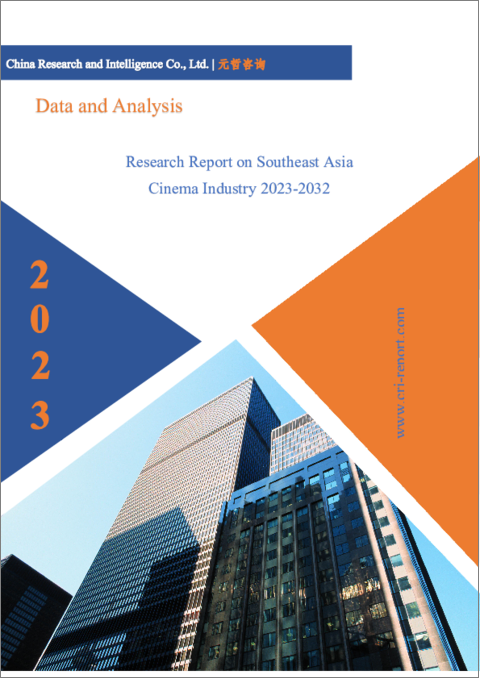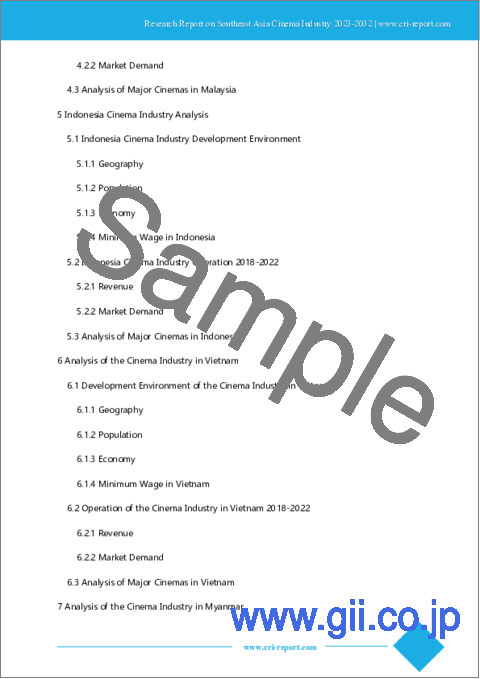|
|
市場調査レポート
商品コード
1224741
東南アジアの映画産業(2023年~2032年)Research Report on Southeast Asia Cinema Industry 2023-2032 |
||||||
| 東南アジアの映画産業(2023年~2032年) |
|
出版日: 2023年02月01日
発行: China Research and Intelligence
ページ情報: 英文 80 Pages
納期: 即日から翌営業日
|
- 全表示
- 概要
- 目次
東南アジアの経済発展に伴い、住民の生活水準が向上し、娯楽商品の需要が高まり、映画館に映画を観に行くことが人々の余暇の選択肢の一つになっています。東南アジアの人口基盤は巨大で、人口構成も比較的若いことから、東南アジアの映画産業の今後の発展には大きな可能性があります。
当レポートでは、東南アジアの映画産業について調査分析し、輸出状況と輸出先、COVID-19の影響、予測収益などの情報を提供しています。
目次
第1章 シンガポールの映画産業の分析
- シンガポールの映画産業の開発環境
- 地域
- 人口
- 経済
- シンガポールの最低賃金
- シンガポールの映画産業の運営(2018年~2022年)
- 収益
- 市場の需要
- シンガポールの主な映画館の分析
第2章 タイの映画産業の分析
- タイの映画産業の開発環境
- 地域
- 人口
- 経済
- タイの最低賃金
- タイの映画産業の運営(2018年~2022年)
- 収益
- 市場の需要
- タイの主な映画館の分析
第3章 フィリピンの映画産業の分析
- フィリピンの映画産業の開発環境
- 地域
- 人口
- 経済
- フィリピンの最低賃金
- フィリピンの映画産業の運営(2018年~2022年)
- 収益
- 市場の需要
- フィリピンの主な映画館の分析
第4章 マレーシアの映画産業の分析
- マレーシアの映画産業の開発環境
- 地域
- 人口
- 経済
- マレーシアの最低賃金
- マレーシアの映画産業の運営(2018年~2022年)
- 収益
- 市場の需要
- マレーシアの主な映画館の分析
第5章 インドネシアの映画産業の分析
- インドネシアの映画産業の開発環境
- 地域
- 人口
- 経済
- インドネシアの最低賃金
- インドネシアの映画産業の運営(2018年~2022年)
- 収益
- 市場の需要
- インドネシアの主な映画館の分析
第6章 ベトナムの映画産業の分析
- ベトナムの映画産業の開発環境
- 地域
- 人口
- 経済
- ベトナムの最低賃金
- ベトナムの映画産業の運営(2018年~2022年)
- 収益
- 市場の需要
- ベトナムの主な映画館の分析
第7章 ミャンマーの映画産業の分析
- ミャンマーの映画産業の開発環境
- 地域
- 人口
- 経済
- ミャンマーの最低賃金
- ミャンマーの映画産業の運営(2018年~2022年)
- 収益
- 市場の需要
- ミャンマーの主な映画館の分析
第8章 ブルネイの映画産業の分析
- ブルネイの映画産業の開発環境
- 地域
- 人口
- 経済
- ブルネイの最低賃金
- ブルネイの映画産業の運営(2018年~2022年)
- 収益
- 市場の需要
- ブルネイの主な映画館の分析
第9章 ラオスの映画産業の分析
- ラオスの映画産業の開発環境
- 地域
- 人口
- 経済
- ラオスの最低賃金
- ラオスの映画産業の運営(2018年~2022年)
- 収益
- 市場の需要
- ラオスの主な映画館の分析
第10章 カンボジアの映画産業の分析
- カンボジアの映画産業の開発環境
- 地域
- 人口
- 経済
- カンボジアの最低賃金
- カンボジアの映画産業の運営(2018年~2022年)
- 収益
- 市場の需要
- カンボジアの主な映画館の分析
第11章 東南アジアの映画産業の見通し(2023年~2032年)
- 東南アジアにおける映画産業の発展に影響を与える要因の分析
- 有利な要因
- 不利な要因
- 東南アジアの映画産業の収益予測(2023年~2032年)
- 東南アジアの映画産業市場の需要分析(2023年~2032年)
- 映画産業に対するCOVID-19の流行の影響
With the economic development of Southeast Asia, the living standard of the residents has improved and the demand for entertainment products has grown, and going to the cinema to watch movies has become an option for people in their leisure time. The population base in Southeast Asia is huge and the population structure is relatively young, so the future development of the cinema industry in Southeast Asia has great potential.
In Vietnam, for example, most of the cinemas are controlled by foreign investors and the scale of local brands is relatively small. CGV, the largest cinema chain in South Korea, entered the Vietnamese market as early as 2005, and Lotte Cinema entered the market in 2008, both of which are ahead of other cinema brands in terms of the number of cinemas, halls and seats in Vietnam.
Southeast Asia in this report includes 10 countries: Singapore, Thailand, Philippines, Malaysia, Indonesia, Vietnam, Myanmar, Brunei, Laos and Cambodia. With a total population of over 600 million by the end of 2021, Southeast Asia has an overall economic growth rate higher than the global average and is one of the key drivers of future global economic growth.
According to CRI's analysis, the economic levels of the 10 Southeast Asian countries vary greatly, with Singapore being the only developed country with a per capita GDP of about US$73,000 in 2021. While Myanmar and Cambodia will have a GDP per capita of less than US$2,000 in 2021. The population and minimum wage levels of each country also vary greatly. Brunei, which has the smallest population, will have a total population of less than 500,000 people in 2021, while Indonesia, which has the largest population, will have a population of about 275 million people in 2021.
CRI expects the cinema industry in Southeast Asia to maintain growth from 2023-2032. On the one hand, as the impact of COVID-19 on the economy is gradually eliminated, theaters are able to reopen, and on the other hand, the improvement of the living standard of the population and more attention to their entertainment needs promote the development of the cinema industry in Southeast Asia.
Topics covered:
- Southeast Asia Cinema Industry Status and Major Sources in 2018-2022
- What is the Impact of COVID-19 on Southeast Asia Cinema Industry?
- Which Companies are the Major Players in Southeast Asia Cinema Industry Market and What are their Competitive Benchmarks?
- Key Drivers and Market Opportunities in Southeast Asia Cinema Industry
- What are the Key Drivers, Challenges, and Opportunities for Southeast Asia Cinema Industry during 2023-2032?
- What is the Expected Revenue of Southeast Asia Cinema Industry during 2023-2032?
- What are the Strategies Adopted by the Key Players in the Market to Increase Their Market Share in the Industry?
- What are the Competitive Advantages of the Major Players in Southeast Asia Cinema Industry Market?
- Which Segment of Southeast Asia Cinema Industry is Expected to Dominate the Market in 2032?
- What are the Major Adverse Factors Facing Southeast Asia Cinema Industry?
Table of Contents
1 Analysis of the Cinema Industry in Singapore
- 1.1 Singapore's Cinema Industry Development Environment
- 1.1.1 Geography
- 1.1.2 Population
- 1.1.3 Economy
- 1.1.4 Minimum Wage in Singapore
- 1.2 Singapore Cinema Industry Operation 2018-2022
- 1.2.1 Revenue
- 1.2.2 Market Demand
- 1.3 Analysis of Major Cinemas in Singapore
2 Analysis of the Cinema Industry in Thailand
- 2.1 Development Environment of the Cinema Industry in Thailand
- 2.1.1 Geography
- 2.1.2 Population
- 2.1.3 Economy
- 2.1.4 Minimum Wage in Thailand
- 2.2 Thailand Cinema Industry Operation 2018-2022
- 2.2.1 Revenue
- 2.2.2 Market Demand
- 2.3 Analysis of Major Cinemas in Thailand
3 Analysis of the Cinema Industry in the Philippines
- 3.1 Development Environment of the Cinema Industry in the Philippines
- 3.1.1 Geography
- 3.1.2 Population
- 3.1.3 Economy
- 3.1.4 Minimum Wage in the Philippines
- 3.2 Philippine Cinema Industry Operation 2018-2022
- 3.2.1 Revenue
- 3.2.2 Market Demand
- 3.3 Analysis of Major Cinemas in the Philippines
4 Malaysia Cinema Industry Analysis
- 4.1 Malaysia Cinema Industry Development Environment
- 4.1.1 Geography
- 4.1.2 Population
- 4.1.3 Economy
- 4.1.4 Minimum Wage in Malaysia
- 4.2 Malaysia Cinema Industry Operation 2018-2022
- 4.2.1 Revenue
- 4.2.2 Market Demand
- 4.3 Analysis of Major Cinemas in Malaysia
5 Indonesia Cinema Industry Analysis
- 5.1 Indonesia Cinema Industry Development Environment
- 5.1.1 Geography
- 5.1.2 Population
- 5.1.3 Economy
- 5.1.4 Minimum Wage in Indonesia
- 5.2 Indonesia Cinema Industry Operation 2018-2022
- 5.2.1 Revenue
- 5.2.2 Market Demand
- 5.3 Analysis of Major Cinemas in Indonesia
6 Analysis of the Cinema Industry in Vietnam
- 6.1 Development Environment of the Cinema Industry in Vietnam
- 6.1.1 Geography
- 6.1.2 Population
- 6.1.3 Economy
- 6.1.4 Minimum Wage in Vietnam
- 6.2 Operation of the Cinema Industry in Vietnam 2018-2022
- 6.2.1 Revenue
- 6.2.2 Market Demand
- 6.3 Analysis of Major Cinemas in Vietnam
7 Analysis of the Cinema Industry in Myanmar
- 7.1 Development Environment of Myanmar Cinema Industry
- 7.1.1 Geography
- 7.1.2 Population
- 7.1.3 Economy
- 7.1.4 Myanmar Minimum Wage
- 7.2 Myanmar Cinema Industry Operation 2018-2022
- 7.2.1 Revenue
- 7.2.2 Market Demand
- 7.3 Analysis of Major Cinemas in Myanmar
8 Brunei Cinema Industry Analysis
- 8.1 Brunei Cinema Industry Development Environment
- 8.1.1 Geography
- 8.1.2 Population
- 8.1.3 Economy
- 8.1.4 Brunei Minimum Wage
- 8.2 Brunei Cinema Industry Operation 2018-2022
- 8.2.1 Revenue
- 8.2.2 Market Demand
- 8.3 Analysis of Major Cinemas in Brunei
9 Analysis of the Cinema Industry in Laos
- 9.1 Development Environment of the Cinema Industry in Laos
- 9.1.1 Geography
- 9.1.2 Population
- 9.1.3 Economy
- 9.1.4 Minimum Wage in Laos
- 9.2 Operation of the Cinema Industry in Laos 2018-2022
- 9.2.1 Revenue
- 9.2.2 Market Demand
- 9.3 Analysis of Major Cinemas in Laos
10 Analysis of the Cinema Industry in Cambodia
- 10.1 Development Environment of the Cinema Industry in Cambodia
- 10.1.1 Geography
- 10.1.2 Population
- 10.1.3 Economy
- 10.1.4 Minimum Wage in Cambodia
- 10.2 Cambodia Cinema Industry Operation 2018-2022
- 10.2.1 Revenue
- 10.2.2 Market Demand
- 10.3 Analysis of Major Cinemas in Cambodia
11 Southeast Asia Cinema Industry Outlook 2023-2032
- 11.1 Analysis of Factors Influencing the Development of the Cinema Industry in Southeast Asia
- 11.1.1 Favorable Factors
- 11.1.2 Unfavorable Factors
- 11.2 Southeast Asia Cinema Industry Revenue Forecast 2023-2032
- 11.3 Southeast Asia Cinema Industry Market Demand Analysis 2023-2032
- 11.4 Impact of COVID -19 Epidemic on Cinema Industry




